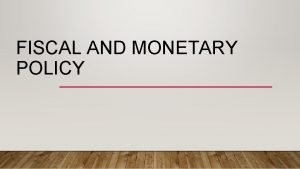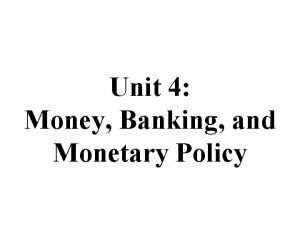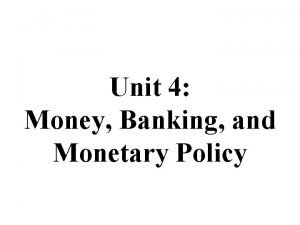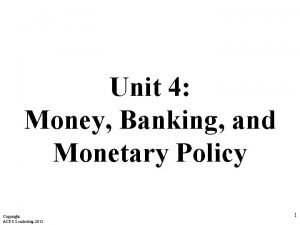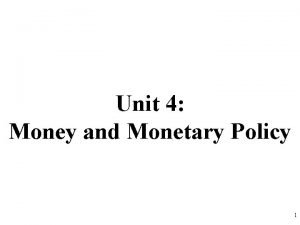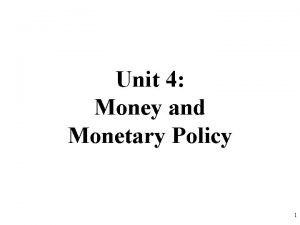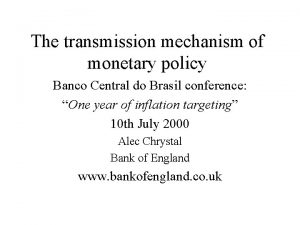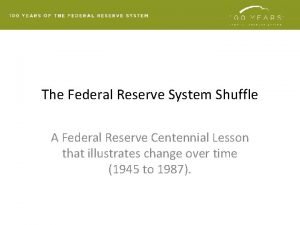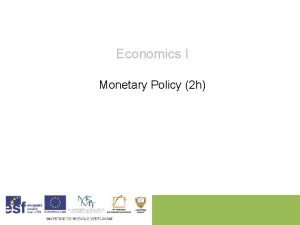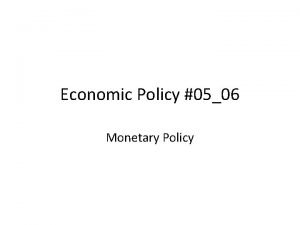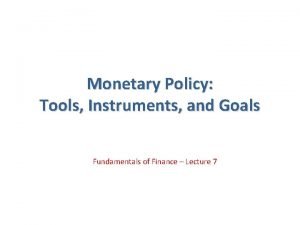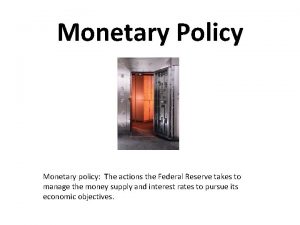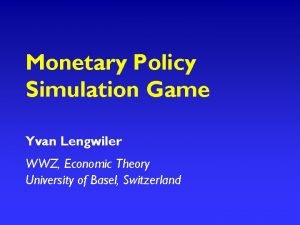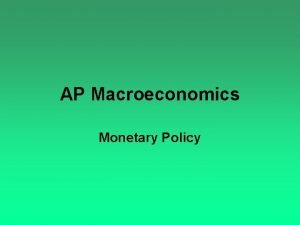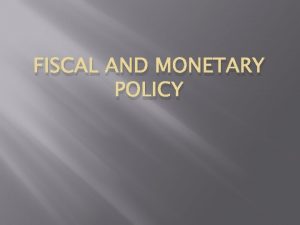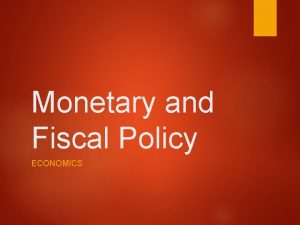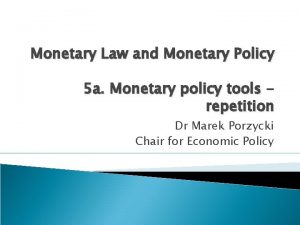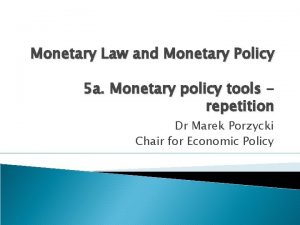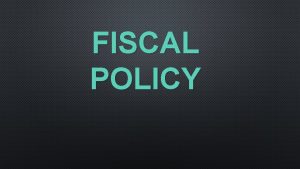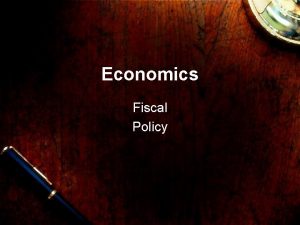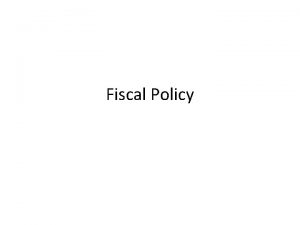Integration of Monetary and Fiscal Policies Fiscal policy



















- Slides: 19

Integration of Monetary and Fiscal Policies

Fiscal policy and monetary policy are the two tools used by the state to achieve its macroeconomic objectives. While for many countries the main objective of fiscal policy is to increase the aggregate output of the economy, the main objective of the monetary policies is to control the interest and inflation rates. The IS/LM model is one of the models used to depict the effect of policy interactions on aggregate output and interest rates. The fiscal policies have a direct impact on the goods market and the monetary policies have a direct impact on the asset markets; since the two markets are connected to each other via the two macrovariables output and interest rates, the policies interact while influencing output and interest rates.

Objective and Preferred Policy Instruments of Fiscal Authority Fiscal Policy iis used by the governments to influence the level of aggregate demand in the economy, in an effort to achieve economic objectives of price stability, full employment and economic growth. The major policy objective of the fiscal authority ● economic stability and ● higher rate of economic growth Fiscal authority instruments ● counter cyclical tax ● spending

Objective and Preferred Policy Instruments of Fiscal Authority It prefers ● lower unemployment rate than lower rate of inflation. Fiscal deficit raises aggregate demand ● and is expansionary and leads to higher interest rate ● and higher level of prices. Budget surplus is contractionary and it lowers the aggregate demand, the interest rate and prices.

Objective and Preferred Policy Instruments of Monetary Authority Monetary Policy Monetary policy is one of the tools that a national government uses to influence its economy. Using its monetary authority to control the supply and availability of money, a government attempts to influence the overall level of economic activity The major policy objective of the monetary Authority ● economic stability and higher rate of economic Growth

Objective and Preferred Policy Instruments of Monetary Authority ❖ Monetary authority instruments ● the interest rate, money supply or the exchange rates. ● It lowers the interest rate in recession and raises in when there is inflationary pressure. ● It may use a monetary policy rule it prefers lower rate of inflation rather than lower rate of unemployment ❖ Lower interest rate raises aggregate demand is expansionary and leads to higher depreciation of currency and higher level of prices over time Higher interest rate is contractionary and it lowers the aggregate demand, causes an appreciation and higher level of prices.


Fiscal and Monetary Policy Coordination? ? ? ● Would it be better to the economy if the fiscal or monetary authority decides its own policies independently without any regards policy choice of another authority? ● would it be better if they cooperate and consult each other while making policy decisions? ● What would be the value of inflation and unemployment rates, output and interest rate when they do not cooperate to each other or when they cooperate and consult each other?

Cooperation of monetary and fiscal policy An appropriate monetary and fiscal policy is needed for achieving targets and stability of economic activities, some special features of these two policies are: ● Monetary policy has less inside time lag so there is less difference in making the policy and implementing it whereas it has more outside time lag means there is more difference in implementing the policy and its outcome. ● Fiscal policy has more inside time lag in comparison to outside time lag because there is political system for finalizing the policy but once the policy is implemented the result comes faster. ● Due to lesser inside time lag it is easy to make the monetary policy and implement it so for day to day activities monetary policy is more effective. But for long run targets fiscal policy is more effective. Simply it is believed that fiscal policy is effective for economic growth and monetary policy is effective for stability.

So now it is clear that there is difference in the tools of monetary and fiscal policy and the impact of these two are also different on the economy but it does not mean that the two policies are independent of each other but they are dependent. Say for example if government is taking public debt for spending it will increase inflation which will create problems for stability in this situation monetary policy is needed. Monetary policy is dependent on fiscal policy for price stability, interest rate and total liquidity. Because till the government will not reduce its fiscal deficit central bank can not implement appropriate monetary policy.

Let us make in-depth study of the relation between monetary policy and fiscal policy of Ind Monetary policy in a planned economy of India cannot be framed independently of fiscal policy as achieving growth with price stability are the objectives of both these policies. In India the Reserve Bank of India has often adopted accommodative monetary policy to Government’s fiscal policy. Prior to 1991 when economic reforms were initiated the basic goal of monetary policy was to neutralize the impact of large fiscal deficits of the Government. To boost public sector investment for accelerating economic growth there was large increase in Government expenditure under various Five Year plans which was financed by borrowing by the Government and deficit financing (i. e. , monetatisation of budget deficit).

In the recent post-reform years, mainly, 2008 -09 accommodative nature of monetary policy to the Government’s fiscal policy may be noted. In October 2008, a severe global financial crisis gripped the world economy. This affected the growth of our exports and also led to the capital outflows from the Indian economy leading to the depreciation of the Indian economy and crash in Indian stock market. As a result, industrial and overall growth of the Indian economy started declining. To check the economic slowdown the Government increased its expenditure, especially on infrastructure projects, and cut indirect taxes such as excise duty service tax to boost private sector investment and expenditure.

To supplement and accommodate Government expansionary policy, the Reserve Bank reversed its earlier tight monetary policy in October 2008 and to boost private sector investment it reduced its repo rate from 9 per cent in July 2008 to 7. 5 per cent in Oct. 2008 and further to 4. 75 per cent in March 2009. Similarly, RBI reduced cash reserve ratio (CRR) from 9 per cent in July 2008 to 6. 5 per cent in Oct. 2008 and further to 5 per cent in March 2009 to make more funds available with banks to buy Government securities for financing sits borrowing and also to the private sector for expanding investment. Thus, the RBI’s monetary policy has been accomodatory in the sense that it provided support to Government’s fiscal stimulus package to promote investment and growth.

IS-LM FRAMEWORK The role of monetary variables in the Keynesian model was first pointed out by Nobel laureate John R. Hicks in 1937. It has been shown by J. R. Hicks and others that with greater insights into the Keynesian theory one finds that the changes in income caused by changes in investment or propensity to consume in the goods market also influence the determination of interest in the money market. The level of income which depends on the investment and consumption demand determines the transaction demand for money which affects the rate of interest. Hicks, Hansen, Lerner and Johnson have put forward a complete and integrated model based on the Keynesian framework where in the variables such as investment, national income, rate of interest, demand for and supply of money are interrelated and mutually interdependent and can be represented by the two curves called the IS and LM curves.

The IS-LM model is the basic model of aggregate demand that incorporates the money market as well as the goods market. It lays particular stress on the channels through which monetary and fiscal policy affect the economy. The IS-LM model is a standard tool of macroeconomic that demonstrates the relationship between interest rates and real output in the goods and services market and the money market. The intersection of the IS and LM curves is the "General Equilibrium" where there is simultaneous equilibrium in both markets.

Monetary – Fiscal Policies Mix and Effect on Equilibrium Income/Output The use of expansionary monetary policy affects the LM curve and shifts it to the right. Expansionary fiscal policy on the other hand, shifts the IS curve to the right. When the government uses a coordinated use of both monetary and fiscal policy, shifts occur in both the LM curve a well as the IS curve. In order to achieve full employment in the economy, assume that government adopts an expansionary mix of monetary and fiscal policies. This has been illustrated in the figure below:

Assuming that the economy is at full employment level of income, the following diagram illustrates the economic situation at full employment and further shows how fiscal-monetary mix policies affect the equilibrium level of income/output. In the figure, income level at full employment is OYF. Initially, at OYF level of income, the IS curve intersects LM curve at point E. When the economy faces a downturn due to the occurrence of unfavorable events, more investment should be injected into the economy. For this, the monetary authority increases the supply of money which shifts the LM curve rightwards to LM 1. The curve LM 1 then intersects with the IS curve to form a new equilibrium point at E 1 where, interest rate is lower at Or 1, and the increased level of income is OY 1.

As shown in the figure, the economy is in equilibrium at point A where IS 1 curve intersects with LM 1 curve. At this point, the rate of interest is Or 2 and income level is OY 1. When the government adopted an expansionary fiscal policy in the form of increased government expenditures (G↑) or decreased taxes (T↓), IS Curve shifts from IS 1 to IS 2. If an expansionary monetary policy is adopted simultaneously, the interest rate further increases to Or 3. So, in order to encourage investment made by business firms and reduce the interest rate to achieve full employment, the central monetary authority increases the supply of money through open market purchase of securities. This causes the Lm curve to shift rightwards from LM 1 to LM 2. The fiscal policy has led to the New IS curve, that is IS 2, and the monetary policy has led to a new LM curve, LM 2. The intersection point of the curve IS 2 and LM 2 is the new equilibrium point B, where the interest rate has fallen to Or 1 and the income level has risen to OY 2. Thus, the expansionary fiscal policy followed by expansionary monetary policy assist one another to maintain an equilibrium level of income/output in the economy.

!!! THANK YOU!!! Q&A
 Unit 5 macroeconomics lesson 2 activity 45 answer key
Unit 5 macroeconomics lesson 2 activity 45 answer key Fiscal vs monetary policy
Fiscal vs monetary policy Contractionary monetary policy graph
Contractionary monetary policy graph Unit 4 money banking and monetary policy
Unit 4 money banking and monetary policy Unit 4 money banking and monetary policy
Unit 4 money banking and monetary policy Unit 4 money and monetary policy
Unit 4 money and monetary policy Unit 4 money and monetary policy
Unit 4 money and monetary policy Unit 4 money and monetary policy
Unit 4 money and monetary policy Transmission of monetary policy
Transmission of monetary policy Lesson quiz 16-1 monetary policy
Lesson quiz 16-1 monetary policy What are the objectives of monetary policy
What are the objectives of monetary policy What is monetary policy
What is monetary policy Monetary policy types
Monetary policy types What are the objectives of monetary policy
What are the objectives of monetary policy What are the objectives of monetary policy
What are the objectives of monetary policy Three tools of monetary policy
Three tools of monetary policy Monetary policy summary
Monetary policy summary Monetary policy simulation game
Monetary policy simulation game Types of monetary policy
Types of monetary policy Instruments of monetary policy
Instruments of monetary policy

